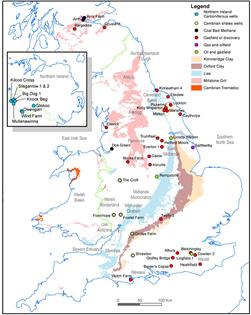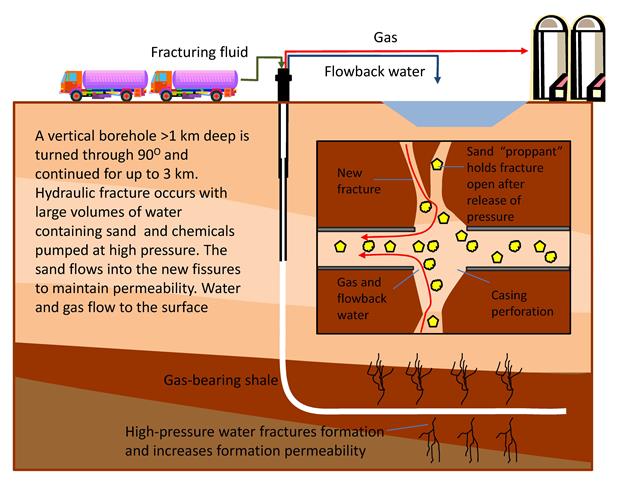Shale Gas Exploitation
Contributed by Marianne Stuart, Team Leader Groundwater Protection with the British Geological Survey

Outcrop of main black shale formations in UK and
selected oil and gas wells and gasfields. © BGS, NERC (2012)
Shale gas is predominantly methane of thermogenic origin and the UK may possess considerable reserves at depth. Significant areas include the Lancashire and Cheshire Basins where exploration has begun. Hydraulic fracturing (“fracking”) in combination with horizontal drilling is an essential part of the shale gas production process. Groundwater may be potentially contaminated by extraction of shale gas both from the constituents of shale gas itself, from the formulation and deep injection of water containing a cocktail of additives used for hydraulic fracturing and from flowback water released during gas extraction which may have a high content of saline formation water. Documented instances of groundwater contamination from the USA are almost all related to the leakage of methane into groundwater. The large volumes of water required may also put pressure on groundwater resources with impacts on other uses and groundwater dependent ecosystems. The vulnerability of groundwater to pollution from fracking operations and shale gas requires the determination of the relative depths of groundwater and shale gas reservoirs and the nature of the intervening strata. The pathways for pollution from surface activities and loss of casing integrity also need to be considered. As yet there is little information for UK so we need to look to the USA experience for transferable knowledge.
Background
Shale gas is predominantly (>90%) methane of thermogenic origin derived from and held in natural fractures and pore spaces or adsorbed onto organic material and minerals in shales at depths of generally more than 1 km.
Interest in shale gas in the UK is increasing as demand for gas steadily grows and North Sea gas reserves are declining with the UK becoming a net importer of gas. The UK may possess considerable reserves of shale gas. Significant areas of interest include the Edale and Widmerpool Gulf in the Midlands and the West Lancashire and Cheshire Basins as well as South Wales, the Weald and Cleveland. Work began first near Blackpool. Shale gas drilling in the UK was given the go-ahead in a report by the Energy and Climate Change Select Committee (2011) which considered the possible impacts on water supplies, energy security and greenhouse gas emissions.
"Fracking"
Shale gas extraction involves drilling of deep horizontal boreholes and enhancing the natural permeability of the shale by hydraulic fracturing (“fracking”). Fluid is introduced to raise the downhole pressure above the fracture pressure of the formation rock creating fissures and interconnected cracks that increase the permeability of the formation. Fracking is used to overcome barriers to gas and fluid flow, one of the primary reasons why historical development of gas from shales has been limited. These barriers include the low natural permeability of shale formations and reduced permeability resulting from permeability impairment caused by drilling activities. Fracking and horizontal drilling have been in use for shale gas in the USA since the late 1940s.
The process typically involves the pumping of a sand-water mixture into the target shale zone at high pressure. The fluid pressure creates fractures or openings through which the sand flows, at the same time the sand acts to prop open the fractures that have been created allowing migration of both gas and water to the borehole. After the pumping pressure is relieved the fracture fluid returns to the surface through the borehole casing. This water is referred to as “flowback”.
Lateral lengths in typical shale gas development wells are from 300 m to more than 1500 m and it is usually not possible to maintain a downhole pressure sufficient to stimulate the entire length of a lateral in a single stimulation. Instead fracking of the horizontal sections is performed in stages by isolating successive portions and performing multiple treatments to stimulate the entire length of the lateral portion of the well. The lifetime of an individual borehole may be only about 7 years.

Overview of hydraulic fracturing (from Stuart 2012 adapted from Gregory et al, 2011)
Water resources issues
The drilling and completion of production boreholes require large quantities of water. Drilling of the vertical and horizontal components of a borehole may require 400–4000 m3 of water to maintain downhole hydrostatic pressure, cool the drill head, and remove drill cuttings. Then, 7000–18,000 m3 of water are needed for fracking of each section. These large volumes of water are typically obtained from nearby surface waters or groundwater and are not generally returned to the source. The volume of water consumed during fracking could make gas production costly and unsustainable in many areas of the world that are water-constrained.
A recent estimate has been made for the UK of the range of water resources potentially required to deliver sustained production. Averaged over a period of 20 years, this would be equivalent to 10% of the UK’s annual consumption assuming annual gas consumption in the UK of around 90 billion cubic metres, similar to 2008 consumption (Wood et al, 2010).
Potential impacts, assuming no controls are in place, would be modifications to groundwater levels as well as surface water levels and stream flow. Operators need this water when drilling activity is occurring, potentially over a relatively short periods of time. Water withdrawals during periods of low stream flow could affect ecosystems, municipal water supplies, recreational activities, and industries.
Contamination sources and pathways
Groundwater may be potentially contaminated by extraction of shale gas both from the constituents of shale gas itself, from the formulation and deep injection of water containing a cocktail of additives used for fracking and from flowback water released during gas extraction which may have a high content of saline formation water.
Documented instances of groundwater contamination from the USA are predominantly related to the leakage of methane into groundwater. Osbourn et al. (2011) showed systematic evidence for methane contamination of drinking water allegedly associated with shale gas extraction, where the average vertical separation between drinking water boreholes and the shale was between 900 and 1800 m.

Methane concentrations as function of distance to nearest gas well (adapted from Osborn, 2011)
Methane concentrations as function of distance to nearest gas well (adapted from Osborn, 2011)
However, there is considerable uncertainty as to the source(s) of methane, its migration pathways and transport processes, and crucially there have been no background surveys in the USA prior to the start of drilling. In general thermogenic gas, such as shale gas, has a high methane content with low but significant concentrations of higher hydrocarbons such as ethane (C2) and propane (C3), with C1/(C2+C3) <100, and enriched 13C with δ13C methane in the range -110 to -55‰ (Révész et al, 2010). In contrast biogenic gas, commonly produced at shallow depths, has C1/ (C2+C3) in the range 1000 to 10,000 and δ13C methane in the range -55 to -20‰ and can be readily distinguished. Shale gas may also contain carbon dioxide, nitrogen, hydrogen sulphide, and rare gases.
The largest additive to fluid used for shale gas fracking is proppant, a granular material, usually sand, to hold or prop open the created fractures that allow gas to flow to the bore. Other commonly used proppants include resin- coated sand, ceramics, and sintered bauxite and zirconium oxide. In addition to water and proppant, many other additives are essential to successful shale gas reservoir fracture stimulation. These include hydrochloric acid, polyacrylamide, mineral oil, isopropanol, potassium chloride and ethylene glycol and low concentrations of pH buffers, corrosion inhibitors, biocides and gelling agents. There are proposals to use more environmentally-friendly compounds in fracking fluid and possibly to use other carriers such as LPG rather than water.
Flowback water is very variable in quality and can range from almost fresh to salinity greater than that of seawater.
Pathways for contaminants to groundwater could potentially include:
- Subsurface permeability created by the fracking process allowing ingress of gas or fracking fluid
-
Accidental releases during preparation of fracking fluids or from fluid leaks, blowouts and casing failures
-
Storage, disposal, treatment or reuse of large volumes of flowback water
Anecdotal reports of health problems in the USA in shale gas exploitation areas for both humans and livestock are ascribed to both water and air pollution.
For UK we need to determine whether shale deposits likely to be exploited for gas are overlain by significant aquifers. The vulnerability of groundwater to pollution from fracking operations and shale gas requires the determination of the relative depths of groundwater and shale gas reservoirs and the nature of the intervening strata. Determining the natural baseline concentrations of methane in these aquifers before any exploration is also essential for any impact assessment.
Links
References
Energy and Climate Change Select Committee. 2011. Environmental Risks of Shale Gas Available from http://www.publications.parliament.uk/pa/cm201012/cmselect/cmenergy/795/79508.htm
Gregory, K B, Vidic, R D, and Dzombak, D A. 2011. Water management challenges associated with the production of shale gas by hydraulic fracturing. ELEMENTS, Vol. 7, 181-186.
Osborn, S G, Vengosh, A, Warner, N R, and Jackson, R B. 2011. Methane contamination of drinking water accompanying gas-well drilling and hydraulic fracturing. Proceedings of the National Academy of Sciences, Vol. 108, 8172-8176.
Révész, K M, Breen, K J, Baldassare, A J, and Burruss, R C. 2010. Carbon and hydrogen isotopic evidence for the origin of combustible gases in water-supply wells in north-central Pennsylvania. Applied Geochemistry, Vol. 25, 1845-1859.
Stuart, M E. 2012 Potential groundwater impact from exploitation of shale gas in the UK. BGS Technical Report OR/12/001. http://nora.nerc.ac.uk/16467/
Wood, R, Gilbert, P, Sharmina, M, Anderson, K, Footitt, A, Glynn, S, and Nicholls, F. 2011. Shale gas: a provisional assessment of climate change and environmental impacts. Tyndall Centre for Climate

Print this Page